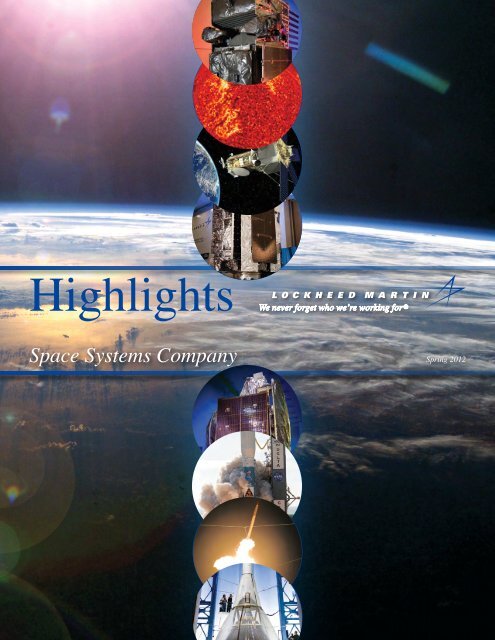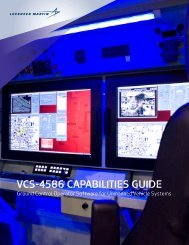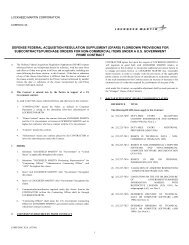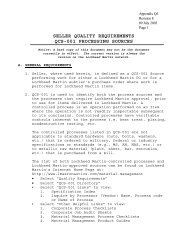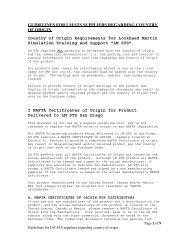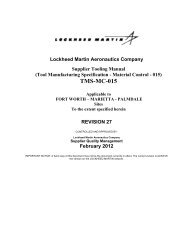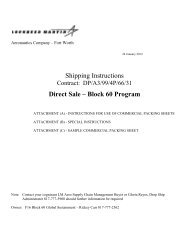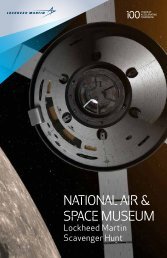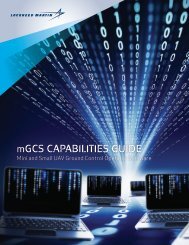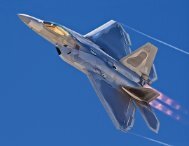Highlights - Lockheed Martin
Highlights - Lockheed Martin
Highlights - Lockheed Martin
- No tags were found...
Create successful ePaper yourself
Turn your PDF publications into a flip-book with our unique Google optimized e-Paper software.
<strong>Highlights</strong>Space Systems Company Spring 2012
Just outside the main gate of ArlingtonNational Cemetery in WashingtonD.C. stands a monument erected in1974 that honors the Seabees of WorldWar II with the following inscription:“With willing hearts and skillfulhands, the difficult we do at once;the impossible takes a bit longer.”This optimistic motto—or a variantof it—has been similarly embracedby other branches of the U.S. ArmedForces. You can still see it today in theconfident, “can do” spirit embraced by legions of dedicated men and womenaround the world who advance the cause of liberty and expand the frontiers ofhuman knowledge on behalf of our nation. They ignore conventional wisdom.Defy the odds. Embrace the impossible.At <strong>Lockheed</strong> <strong>Martin</strong> Space Systems Company, we count ourselves amongthose who dare to challenge the impossible every day. We share their passion forinvention, commitment to success, and dedication to excellence.Those values date back to 1912, the year that aviation pioneers Glenn<strong>Martin</strong> and <strong>Lockheed</strong> brothers Allan and Malcolm founded the two namesakeaeronautics companies that would evolve, expand, and eventually join forcesas <strong>Lockheed</strong> <strong>Martin</strong> Corporation. One hundred years later, their “impossibledreams” have not only survived but flourished. Their journey was not easy—andthere were many setbacks along the way—but they never gave up.As the Corporation enters its centennial year, we honor all those who followedin our founders’ footsteps—challenging assumptions, charging ahead, andchanging the world for the better. Their flights of imagination, innovation, anddetermination set the stage for the achievements celebrated in this annual editionof <strong>Highlights</strong>.We also thank you, our customers, partners, and friends, for joining us onthis journey. With your help we will continue to bring you our very best, withwilling hearts and skillful hands.TABLE OF CONTENTSPageStrategic and Missile Defense Systems 2Global Communications Systems 6Sensing and Exploration Systems 10Human Space Flight 14Surveillance and Navigation Systems 18Special Programs 22Advanced Technology Center 24Community Outreach 27Joanne MaguireExecutive Vice President, <strong>Lockheed</strong> <strong>Martin</strong> Space Systems Company
STRATEGIC ANDMISSILE DEFENSE SYSTEMSAs a leader in strategic missile andmissile defense systems, <strong>Lockheed</strong><strong>Martin</strong> Strategic and Missile DefenseSystems focuses on reliability andaffordability in designing, producingand sustaining ballistic missiles,interceptors, target missiles, andreentry systems.In the missile defense mission area, the Terminal HighAltitude Area Defense (THAAD) weapon system achievedsignificant milestones in 2011. In December, <strong>Lockheed</strong><strong>Martin</strong> received a contract to produce THAAD for the U.S.Missile Defense Agency (MDA) and the United Arab Emirates.One of the most notable milestones of the year, thiscontract is also the first foreign military sale of the system.The contract includes the production of two THAADWeapon Systems and additional maintenance and supportequipment.<strong>Lockheed</strong> <strong>Martin</strong> currently is under contract to the MDAfor four THAAD batteries for operation by U.S. Army warfighters,totaling 98 interceptors, 18 launchers, and 6 battlemanagers.During a flight test in October at the Pacific MissileRange Facility on Kauai, Hawaii, the U.S. Army Test andEvaluation Command, the MDA, and the U.S. Army challengedTHAAD to track, detect, and intercept two differenttargets utilizing two THAAD interceptors – a first for thesystem. During the successful mission, the THAAD missilesystem intercepted air-launched and sea-launched shortrangeballistic missile targets.A key element of the nation’s Ballistic Missile DefenseSystem, THAAD will defend the U.S., its deployed andallied forces, population centers, and critical infrastructureagainst short- to intermediate-range ballistic missiles.THAAD is the only missile defense system with the operationalflexibility to intercept in both the endo- and exo-atmospheresto provide versatile capability to the warfighter.Continued on page 4TWO AGAINST TWO. A Terminal High Altitude Area Defense(THAAD) interceptor launches during the system’s InitialOperational Test and Evaluation in October, 2011 at the PacificMissile Range Facility, Kauai, Hawaii. During the test, the THAADsystem engaged and simultaneously intercepted two ballistic missiletargets.2 3
Continued from page 3MISSION COMPLETED. An infrared image shows the interceptionof the Missile Defense Agency’s LV-2 Intermediate-Range BallisticMissile Target, after its successful launch in April 2011 fromthe U.S. Army’s Reagan Test Site at Kwajalein Atoll in the Republicof the Marshall Islands.The MDA awarded <strong>Lockheed</strong> <strong>Martin</strong> a contract forconcept definition and program planning for the StandardMissile-3 Block IIB (SM-3 IIB) in 2011. The new missile willprovide early intercept capability against long-range ballisticmissile threats. It will be a key element of the fourth phaseof the government’s Phased Adaptive Approach, which willprovide enhanced capabilities against threats on a global basis.The missile will be integrated into the Aegis Weapon System,with the Aegis BMD 5.1 Fire Control and the MK 41 VerticalLaunching System, as part of the land-based Aegis Ashorecapability. In preparation for bidding for the upcoming productdevelopment phase, <strong>Lockheed</strong> <strong>Martin</strong> has selected its Courtland,Ala., facility for future production of the SM-3 IIB.A battle manager developed by <strong>Lockheed</strong> <strong>Martin</strong> SpaceSystems performed in the successful first flight test of theMedium Extended Air Defense System (MEADS) conductedin 2011 at White Sands Missile Range, N.M. ThePAC-3 Missile Segment Enhancement (MSE) MEADSCertified Missile Round and the lightweight launcher alsowere employed in the test. The test demonstrated an unprecedentedover-the-shoulder launch of the MSE missile againsta simulated target attacking from behind. MEADS International,a multinational joint venture, is the MEADS primecontractor for the NATO MEADS Management Agency.<strong>Lockheed</strong> <strong>Martin</strong> is leveraging its satellite and missiledefense domain expertise on the manufacturing and productionreadiness integrated systems engineering team for theMDA’s Precision Tracking Space System (PTSS). PTSSwill provide the MDA with a space-based system for postboosttracking of ballistic missile threats in a global infrastructure.<strong>Lockheed</strong> <strong>Martin</strong> was awarded a contract in 2011as part of a team led by Johns Hopkins University AppliedPhysics Laboratory.On the testing side of missile defense, <strong>Lockheed</strong> <strong>Martin</strong>’sTargets and Countermeasures Program successfully providedand launched four target missiles in 2011. This brought<strong>Lockheed</strong> <strong>Martin</strong>’s reliability record to 42 successful targetmissions out of 43 since 1996. This unmatched 98 percentMission Success rate has included unitary and separatingtargets, spanning land, sea, and air launches for testing of theBallistic Missile Defense System. It also includes three missionsof the new LV-2 Intermediate-Range Ballistic Missiletarget. <strong>Lockheed</strong> <strong>Martin</strong> provides a full spectrum of targetmissiles, with a focus on threat-representative capabilities forrealistic testing and production efficiencies for affordability.In the strategic deterrence mission area, the U.S. Navyconducted two successful flight tests in 2011 of the <strong>Lockheed</strong><strong>Martin</strong>-built Trident II D5 Fleet Ballistic Missile(FBM). The D5 missile has achieved 136 successful testflights since 1989, underscoring the credibility of the seabasedstrategic deterrent. As the U.S. Navy’s missile primecontractor, <strong>Lockheed</strong> <strong>Martin</strong> also provides operations andmaintenance support at U.S. strategic weapons facilities,and program management and engineering services for theU.K.’s Trident II D5 FBM program. <strong>Lockheed</strong> <strong>Martin</strong> U.K.Strategic Systems provides subsystem engineering, maintenance,and support for the Royal Navy’s Trident StrategicWeapon System.In supporting the U.S. Air Force’s IntercontinentalBallistic Missile (ICBM) program, <strong>Lockheed</strong> <strong>Martin</strong> serves acritical role in the sustainment of the Minuteman III strategicweapon system. This includes refurbishing reentry vehiclearming and fuzing assemblies, providing Safety EnhancedReentry Vehicle flight hardware and ground support equipment,and developing Reentry Field Support Equipment.<strong>Lockheed</strong> <strong>Martin</strong> has supported the land-based deterrent formore than half a century, delivering Atlas, Titan, and Peacekeepermissiles, reentry systems, and command and controlground systems, and has been the principal designer, manufacturer,and sustainer of Minuteman III reentry systemssince the 1960s.For the conventional prompt global strike mission area,<strong>Lockheed</strong> <strong>Martin</strong> is developing and demonstrating nextgenerationtechnologies. The Defense Advanced ResearchProjects Agency’s (DARPA’s) Falcon Hypersonic TestVehicle-2 (HTV-2), developed by <strong>Lockheed</strong> <strong>Martin</strong>, made asecond flight in 2011 to increase technical understanding ofthe hypersonic regime. DARPA demonstrated stable aerodynamicallycontrolled Mach 20 flight for nearly three minutesin its attempt to fly the fastest aircraft ever flown. This featwas the result of many scientific and technological advances.The Falcon HTV-2 is an unmanned, rocket-launched, maneuverableaircraft that glides through the Earth’s atmosphere atincredibly fast speeds – approximately 13,000 miles per hour.DARPA’s Falcon HTV-2 program is a multiyear researchand development effort to increase the technical knowledgebase and advance critical technologies to make long-durationhypersonic flight a reality.FROM THE SEA. The U.S. Navy launches an unarmed Trident IID5 missile from the Ohio-class fleet ballistic missile submarine USSNevada (SSBN 733) off the coast of Southern California in March2011. The test launch was part of the U.S. Navy Strategic SystemsPrograms’ demonstration and shakedown operation certificationprocess. The successful launch certified the readiness of an SSBNcrew and the operational performance of the submarine’s strategicweapon system before returning to operational availability.HYPERSONIC FLIGHT. An artist’s concept portrays the Defense Advanced Research Projects Agency’s Falcon HypersonicTechnology Vehicle-2, which demonstrated stable, aerodynamically controlled Mach 20 flight for nearly three minutes inAugust 2011.4 5
GLOBAL COMMUNICATIONSSYSTEMSWith a long history of innovation,reliability and performanceexcellence, Global CommunicationsSystems (GCS) is a leading providerof the world’s most advancedcommunications systems forgovernment and commercialcustomers around the globe. TheGCS team delivered significantcustomer value in 2011, reflectingits ongoing focus on programexecution, quality, efficiency, andaffordability, and is on track toachieve four Mission Success eventsin 2012 for critical national securityand commercial imperatives.The Advanced Extremely High Frequency (AEHF)team overcame formidable challenges to successfully andsafely propel the first satellite (SV-1) into its geosynchronousorbit slot with all subsystems operating nominally. The teamhas since completed on-orbit checkout and handover to theU.S. Air Force, achieving its Mission Success commitmentand paving the way for operational use.The second AEHF satellite (SV-2) completed environmentaltesting, followed by the Final Integrated System Test,and is now gearing up for launch in mid-2012 aboard an AtlasV rocket. SV-3 also completed environmental testing andis proceeding through a series of final factory tests to preparefor flight readiness in late 2012.AEHF will provide vastly improved global, survivable,highly secure, protected communications for warfightersoperating on ground, sea, and air platforms.Space Systems is currently under contract to providefour AEHF satellites and the Mission Control Segment to itsAir Force customer. Procurement of long-lead componentsfor the fifth and sixth AEHF satellites is underway with aproduction contract expected this year.Work on the Mobile User Objective System (MUOS),which will provide next-generation narrowband tacticalsatellite communications for mobile warfighters, continuedwith positive momentum. The first satellite was delivered toCape Canaveral Air Force Station, where it was successfullylaunched aboard an Atlas V rocket in February of 2012. Theteam will execute a 90-day detailed checkout of all spacecraftsystems before transfer to the U.S. Navy customer inmid-2012 in preparation for operations.The second MUOS space vehicle is on track for completionof environmental testing in 2012, validating its performancein a simulated space environment, in preparation forlaunch in 2013. The third, fourth, and fifth MUOS satellitesare also steadily progressing in production.MUOS will augment and replace the current legacyUltra High Frequency system and provide 10 times morecommunications capability to the user, including simultaneousvoice, video, and data.Continued on page 8MISSION READY. On January 29, 2012, <strong>Lockheed</strong> <strong>Martin</strong> encapsulated the first MUOS satellite into itslaunch vehicle payload fairing in preparation for its February 24 launch aboard an Atlas V rocket.6 7
Continued from page 6The Milstar and Defense Satellite CommunicationsSystem (DSCS) III operational programs continued to demonstrateoutstanding performance in 2011.The first Milstar II military communications satellitesurpassed its 10-year design life of on-orbit service, providingthe nation’s warfighters with secure and reliable communicationssince its successful launch on Feb. 27, 2001.DEPENDABILITY ON ORBIT. The BSAT-3c/JCSAT-110Rbroadcasting satellite is expected to provide more than 15 yearsof service for Japanese companies B-SAT and SKY PerfectJSAT, which jointly procured the satellite.Designated Milstar II Flight-4, the satellite is the first ofthree Block II spacecraft on orbit with a variety of enhancedcommunications features for the U.S. military. The fivesatelliteMilstar constellation, which achieved over 60 yearsof combined successful operations, provides a protectedcommunication network for the joint forces of the U.S.military and can transmit voice, data, imagery, and videoteleconferencing.In addition to this 10-year milestone for Flight-4, the firsttwo Milstar satellites have been on orbit for over 15 years –far exceeding their 10-year design life. In 2011, the DSCS IIIconstellation reached a significant milestone by surpassing225 years in orbit. DSCS is referred to as the “workhorse”of military satellite communications. The system providesuninterrupted secure voice and high data rate communicationsto U.S. government users, essential tools in monitoring eventsand deploying and sustaining forces anywhere in the world.In 2011, GCS Commercial Programs delivered theBSAT-3c/JCSAT-110R broadcasting satellite to the BroadcastingSatellite System Corporation (B-SAT) and SKYPerfect JSAT Corporation. This satellite is located at orbitallocation 110 degrees east and will provide more than 15years of service for Japanese companies B-SAT and SKYPerfect JSAT, which jointly procured the satellite. BSAT-3c/JCSAT-110R incorporates two independent Ku-band payloadswith 12 direct broadcast channels and 12 fixed directcommunication channels providing uplink and downlinkcoverage throughout Japan. BSAT-3c/JCSAT-110R wasdesigned entirely with flight-proven components integratedinto the highly reliable A2100 satellite platform.Also this past year, the first A2100 commercial communicationssatellite achieved its 15-year design life ofon-orbit service. Launched as GE-1 on Sept. 8, 1996 aboarda <strong>Lockheed</strong> <strong>Martin</strong> Atlas IIA rocket, the satellite is one of 37operational A2100 commercial communications satellites.The A2100 fleet has accumulated nearly 350 years of servicein orbit, demonstrating <strong>Lockheed</strong> <strong>Martin</strong>’s leadership in providingreliable design, manufacturing, and on-orbit deliveryfor customers around the globe.This year a dual launch aboard an Ariane 5 launchvehicle will carry JCSAT-13 and VINASAT-2 to orbit, markingthe 100th and 101st commercial and GEO satellites GCSCommercial Programs has delivered to customers worldwide.JCSAT-13 is being delivered to long-time customerSKY Perfect JSAT, which has procured six previous satellitesfrom GCS Commercial Programs. It will feature an all Kubandpayload incorporating 44 fixed high-power communicationchannels that will provide uplink and downlink coverageover Japan, Asia, and Oceania. Additionally, two steerableantennas provide coverage for new and emerging markets aswell as quick response coverage, spanning the visible Earthfrom the orbital slot.VINASAT-2 is the second satellite order received fromVietnam Posts and Telecommunications Group. <strong>Lockheed</strong><strong>Martin</strong> successfully delivered VINASAT-1, the first satelliteever for the nation of Vietnam, in 2008. VINASAT-2 willfeature 24 Ku-band fixed high power communication channels,providing uplink and downlink coverage over Vietnam,Cambodia, Thailand, and Laos.Commercial Programs wrapped up 2011 with a contractfrom NewSat Limited of Australia to build its first satellite,known as Jabiru-1. With launch planed for the second half of2014, Jabiru-1 will provide Ka broadband services across theMiddle East, Africa, and Asia and is designed for an in-orbitlife of 15 years.READY FOR LAUNCH. The second AEHF satellite undergoes final inspection in Sunnyvale, Calif. prior to shipmentto Cape Canaveral Air Force Station, Fla., for its planned 2012 launch aboard an Atlas V launch vehicle.8 9
SENSINGAND EXPLORATION SYSTEMSOFF TO JUPITER. As the archetype of giant planets, Jupiter can provide theclues we need to understand the origin of our own solar system and theplanetary systems currently being discovered around other stars. Launched inAugust, Juno will peer down into Jupiter’s atmosphere and study its luminousaurora and polar magnetosphere. When it approaches Jupiter, Juno will becomeone of the fastest man-made objects ever built as it enters orbit at 135,000 mph.2011 was a banner year for spaceexploration, as SSC and its partnerslaunched new missions to the Moon,Mars, and Jupiter, while plottingadventures to asteroids andobserving encounters with comets.NASA’s Stardust-NExT spacecraft made a Valentine’sDay deep-space rendezvous with comet Tempel 1 and took72 images. This was the second comet Stardust has visited.In 2004, the venerable spacecraft flew by comet Wild 2 andcollected samples, which were brought back to Earth. Just38 days after the Tempel 1 flyby, the Stardust flight team atSpace Systems Company in Denver, Colo. sent those lastcommands to the spacecraft that burned its fuel to depletionand ended the probe’s 12-year, two-mission journey.In May, NASA selected the team of the University ofArizona, Goddard Space Flight Center and <strong>Lockheed</strong> <strong>Martin</strong>for the next New Frontiers mission called OSIRIS-REx. TheOrigins, Spectral Interpretation, Resource Identification,Security-Regolith Explorer (OSIRIS-REx) mission isscheduled for launch in 2016 and will return the first samplesever taken from a special type of asteroid holding clues to theorigin of the solar system and likely organic molecules thatmay have seeded life on Earth. Space Systems Company willdesign, build, and operate the spacecraft.On Aug. 5 NASA’s Juno spacecraft, designed and builtby SSC, was launched aboard an Atlas V 551 rocket providedby United Launch Alliance (ULA). The large Jupiter orbiterwill travel 1.7 billion miles over the next five years on itsround-about trek to Jupiter. The mission’s flight operationsteam controls the solar-powered, spin-stabilized spacecraftfrom SSC’s Mission Support Area in Denver. After itsarrival in July 2016, the spacecraft will spend a little morethan a year orbiting over the poles of the gas giant whilestudying the planet’s origins, structure, atmosphere, and magnetosphere.The mission is led by the Southwest ResearchInstitute and is managed by the Jet Propulsion Laboratory(JPL).Just one month following the Juno launch, NASA, <strong>Lockheed</strong><strong>Martin</strong>, and ULA launched the two GRAIL spacecraftaboard a Delta II Heavy launch vehicle. The two GravityRecovery And Interior Laboratory (GRAIL) roboticspacecraft took the long route to the moon and 3½ monthslater were inserted into orbit. GRAIL-A, renamed “Ebb,” wascaptured into orbit by the moon’s gravity on New Year’s Eve2011, and its twin, GRAIL-B, dubbed “Flow,” went into orbit25 hours later on New Year’s Day 2012. Designed, built, andnow operated by SSC for JPL, the small orbiters will map thegravitational field of the moon in unprecedented detail. Themission is led by the Massachusetts Institute of Technologyand managed by JPL.Continued on page 1210 11
MAPPING THE MOON. GRAIL is the first time two robotic spacecraft have been flown in the same precise orbit around a planetary bodyother than Earth. The gravitational map created by the GRAIL mission will improve our knowledge of the near side of the moon gravity by100 times and the far side by 1,000 times. This knowledge will enable scientists to understand the moon’s interior composition andstructure, which can lead to understanding its origin.Continued from page 11SSC’s Sensing & Exploration Systems (S&ES) line ofbusiness saw three launches in a four-month period. NASA’sMars Science Laboratory (MSL) was the third. Launchedon Nov. 26, 2011, it was successfully sent on its way toMars by a ULA Atlas V 541. The mission’s large Curiosityrover is encapsulated and protected in an aeroshell that wasdesigned and built by SSC. The rover, built by JPL, will seekto determine whether the Red Planet was, or still is, habitablefor microbial life. The nearly 15-foot-diameter aeroshell isa blunt-nosed cone that protects Curiosity from the intenseheat and friction that will be generated as the system descendsthrough the Martian atmosphere in early August 2012. <strong>Lockheed</strong><strong>Martin</strong> has designed and built every aeroshell flown byNASA to Mars dating back to the Viking landers.NASA selected three missions for Phase A studies forits next Discovery science mission. After detailed review in2012, NASA will select one to continue development andlaunch in 2016. SSC is the industry partner on all three potentialmissions. InSight would study the structure and compositionof the interior of Mars. TiME would land in – and floaton – a large methane-ethane sea on Saturn’s moon Titan.Comet Hopper would study cometary evolution by landingon a comet many times and observing its changes. Two ofthe missions would use the Advanced Stirling RadioisotopeGenerator (ASRG) to generate electricity. The ASRG isunder development at SSC’s Valley Forge, Pa. facility.The Mars Atmosphere and Volatile EvolutioN(MAVEN) mission reached a major milestone during thesummer when it successfully completed its Critical DesignReview (CDR). Led by the University of Colorado and managedby NASA’s Goddard Space Flight Center, MAVEN willbe the first mission devoted to understanding the Martianupper atmosphere. SSC is building the spacecraft and recentlycompleted the main spacecraft structure. The Martianorbiter is scheduled for launch in November 2013.In early 2011, the SSC team designing NASA andNOAA’s Geostationary Operational EnvironmentalSatellite R-series (GOES-R) weather satellite successfullycompleted its system Preliminary Design Review, a majormilestone in the program’s development. GOES-R is thenation’s next generation geostationary weather satellite andis scheduled for a 2015 launch.S&ES’s Coherent Technologies deployed its WindTracer ®Doppler Lidar systems to two airports in Germany in additionto Columbia Gorge, Oregon and New Jersey for windfarm site analysis.NASA announced missions selected for Phase A studiesfor its next Explorer program. SSC is on the team thatis proposing the Observatory for Heteroscale Magnetosphere-IonosphereCoupling (OHMIC) mission led by theSouthwest Research Institute. If chosen, OHMIC would usea pair of spacecraft, built by SSC, to study the processes thatprovide energy to power space weather storms. The AdvancedTechnology Center (ATC) would design the electronics forone of the cameras on OHMIC, and an ATC physicist willserve as co-investigator for the mission. Explorer missionwinners will be announced in early 2013.In addition, NASA announced Explorer technologydevelopment funding for the Exoplanetary CircumstellarEnvironments and Disk Explorer (EXCEDE) mission.SSC is on the EXCEDE team led by the University of Arizonathat is developing studies of the formation, evolution,and architectures of exoplanetary systems, and characterizingcircumstellar environments in habitable zones.12 13
HUMAN SPACE FLIGHTIn 2011, <strong>Lockheed</strong> <strong>Martin</strong> bid a fondfarewell to the final Space Shuttlewhile preparing for the next steps inhuman space exploration.The final mission of NASA’s Space Shuttle program inJuly 2011 was an opportunity for Space Systems Company(SSC) employees to look back with pride on the role theyplayed since the very beginning.The <strong>Lockheed</strong> <strong>Martin</strong>-built systems included theExternal Tank and the Space Shuttle Thermal Protection.Solar systems exploration missions launched from the shuttleincluded the 1989 Magellan mission to Venus – for whichSSC in Denver, Colo. built the spacecraft and provided missionoperations.Denver personnel also built a key component of theattitude and articulation control system electronics that controlledthe 1989 Galileo spacecraft on its mission to Jupiter,and provided three of the six scientific instruments on theprobe. The Galileo radioisotope thermoelectric generator(RTG) was built at the SSC facility in Valley Forge,Pa., where the RTG for the Ulysses – the NASA/ESAmission that studied the heliosphere – was also built.The Hubble Space Telescope was designed and built atSSC in Sunnyvale, Calif., carried to space on the shuttlein 1990, and serviced and upgraded by spacewalkingshuttle astronauts in 1993, 1997, 1999, 2002 and 2009.Communications satellites built in Valley Forge,Pa. and East Windsor, N.J. were deployed into spaceon four shuttle missions in 1985, 1986 and 1993. TheISS solar arrays, designed and built in Sunnyvale, themost powerful electricity-producing arrays ever put intoorbit, were launched to the station on four shuttle missionsin 2000, 2006, 2007 and 2009.<strong>Lockheed</strong> <strong>Martin</strong> in Denver built the Manned ManeuveringUnit, a vehicle that enabled astronauts to flyuntethered, away from the shuttle, to perform a varietyof extravehicular activities, such as satellite retrieval, scienceinvestigations and observations, in-space construction,and rescue operations. Solar physics was the focusof two shuttle flights, when the crippled Solar Max satellitewas captured from orbit in 1984 and repaired byastronauts in the payload bay, and in 1985 an ATC-builtsolar instrument was operated on orbit by a <strong>Lockheed</strong><strong>Martin</strong> scientist aboard the shuttle Challenger.On STS-134, Endeavour astronauts put to thetest a new navigation sensor developed for the OrionMulti-Purpose Crew Vehicle, being built by SSC. TheSensor Test for Orion Relative Navigation Risk Mitigation(STORRM) sensing functions demonstrated duringdocking, undocking and re-rendezvous operations havebeen identified as a critical technology needed for spaceexploration missions of the future.Continued on page 16END OF AN ERA. At NASA’s Kennedy Space Center inFlorida, space shuttle Atlantis lifts off from Launch Pad 39Aout of billows of smoke and flame on its STS-135 missionto the International Space Station. Atlantis with its crewof four: Commander Chris Ferguson, Pilot Doug Hurley,Mission Specialists Sandy Magnus and Rex Walheim, liftedoff at 11:29 a.m. EDT on July 8, 2011. STS-135 was the33rd flight of Atlantis, the 37th shuttle mission to the spacestation, and the 135th and final mission of NASA’s SpaceShuttle Program.14 15
Continued from page 14Charting a new path to ensure safe, affordable andsustainable human space exploration, NASA confirmed theOrion spacecraft as the Agency’s vehicle of choice to supportAmerica’s future human space flight endeavors beyondEarth’s orbit.Over the past year, the <strong>Lockheed</strong> <strong>Martin</strong> Orion teammade significant strides in building and testing the world’sfirst interplanetary spacecraft that will carry astronauts todestinations never before explored by humans. In early2011, <strong>Lockheed</strong> <strong>Martin</strong> completed the first Orion spacecraft,which was subjected to a series of rigorous ground tests thatvalidated the vehicle’s ability to withstand the harsh environmentsof a deep space mission. The ground test vehiclestack – which consists of the Orion crew module, launchabort system, and a service module structure – enduredacoustic, vibration, and modal tests at the company’s Denver,Colo. facility.Making a significant private investment in future spaceexploration, <strong>Lockheed</strong> <strong>Martin</strong> opened a spacious, state-ofthe-artSpace Operations Simulation Center at its Denverfacility. The 41,000-square-foot facility provides a simulatedspace dynamics and lighting environment that is unparalleledin the space industry.In May, Space Shuttle Commander Mark Kelly conductedan unprecedented on-orbit maneuver to test Orion’snext generation docking sensor during the STS-134 mission.This system was also successfully tested post-flight in theSpace Operations Simulation Center. This test demonstratedthe center’s ability to replicate on-orbit conditions that affectrelative navigation, lighting and motion control in space.By fall, <strong>Lockheed</strong> <strong>Martin</strong> began fabricating the Orionspacecraft slated for NASA’s first Exploration Flight Testbeyond low Earth orbit. The team completed the initial seriesof friction stir welds at the Michoud Assembly Facility inNew Orleans where the spacecraft structure will be builtbefore being shipped to Kennedy Space Center’s Operations& Checkout Facility for continued processing through finalassembly and testing.In addition, the software integration team completedsuccessful hardware/software integration simulations at theExploration Development Lab in Houston that demonstratedOrion’s avionics hardware and flight software can performa high-speed orbital entry from a deep space mission. Thatwork will continue to progress throughout the next year.In 2012, the <strong>Lockheed</strong> <strong>Martin</strong> team will forge aheadtoward Orion’s Exploration Flight Test that will simulate ahigh-energy re-entry from a deep space mission. This testwill validate several systems and mission events to reducethe overall risk for Orion’s first human-rated launch. NASAhas slated the orbital flight test for 2014 and the first integrateduncrewed flight of Orion and the Space LaunchSystem for 2017.PRACTICE MAKES PERFECT. <strong>Lockheed</strong> <strong>Martin</strong>’s Space Operations Simulation Center in Denver, Colo., simulates on-orbitdocking maneuvers with full-scale Orion and International Space Station mockups. The 41,000 square-foot-facility represents independentcommercial investment by <strong>Lockheed</strong> <strong>Martin</strong> and the State of Colorado to help mitigate risk for future space exploration initiatives. Thespacious center includes an 18,000 square-foot high bay area being used to validate Orion’s relative navigation system.STACKING UP. <strong>Lockheed</strong> <strong>Martin</strong> engineers successfullycompleted a series of acoustic tests on the Orion groundtest vehicle, which consists of two major components ofthe Orion spacecraft: the crew module and the launchabort system. More than 600 instruments, including500 accelerometers and 100 microphones, were placedthroughout the Orion crew module/launch abort systemstack to test critical components of the spacecraft such asavionics, propulsion, and crew life support16 17
SURVEILLANCE ANDNAVIGATION SYSTEMSAffordability. Innovation. MissionSuccess. Reliability. Partnerships.These are the themes the Surveillanceand Navigation Systems line ofbusiness focused on in 2011 whiledelivering national security spacesolutions for customers who protectlives, preserve freedom and advancethe cause of civilization.With GEO-1 joining the SBIRS Highly Elliptical Orbit(HEO) payloads already on-orbit, the SBIRS constellationbegan to take shape in 2011.While pausing briefly to savor the successful launch, theteam remained focused on maturing the ground system anddelivering the next batch of SBIRS spacecraft to improve thenation’s missile warning constellation.Leveraging lessons learned from GEO-1, program personnelexecuted an efficient environmental test phase for thesecond SBIRS geosynchronous (GEO-2) satellite.Continued on page 20SPECIAL DELIVERY. Workers load the first dedicated SBIRS satellite onto anAir Force C-5 cargo plane for its journey to Cape Canaveral Air Force Station,Fla. At right, engineers encapsulate the satellite into its launch vehicle prior tothe historic May 7 launch.Most notably, the Space Based Infrared Systems(SBIRS) team executed and celebrated the historic launch ofthe U.S. Air Force’s first dedicated geosynchronous (GEO-1)spacecraft in the spring of 2011.The SBIRS program delivers timely, reliable, accurateand vital missile warning information to the President of theUnited Sates, the Secretary of Defense, Combatant Commanders,Joint Task Force Commanders, the intelligencecommunity, and other key decision makers.SBIRS GEO-1, the most technologically advancedmilitary infrared satellite ever developed, is vastly improvingmissile warning capabilities for the nation whilesimultaneously enhancing its missile defense, technicalintelligence, and battlespace awareness mission areas.Following launch, the satellite performed exceptionallyas it deployed its instruments, beamed downits first infrared image, and completed early orbitcalibration and testing.18 19
SPECIAL PROGRAMSSpecial Programs demonstratedsuperior performance, relevance,and affordability in 2011, deliveringhigh-quality, game-changingsolutions for critical nationalsecurity, intelligence, and warfighterimperatives.The Special Programs team developing GeoEye’snext-generation, high-resolution Earth-imaging satellite,known as GeoEye-2, achieved key milestones, reflecting itsunrelenting focus on Operational Excellence and MissionSuccess.The team began space vehicle integration with the deliveryof the integrated propulsion system from the <strong>Lockheed</strong><strong>Martin</strong> Space & Technology Center in Stennis, Miss. and ison track to be ready for launch in early 2013.The start of vehicle integration marked the on-scheduleprogress of installation and testing of satellite componentsand subsystems in preparation for the delivery of the satellite’shigh-resolution imaging payload in early 2012.Special Programs is developing the spacecraft under afixed-price contract with GeoEye. Once operational in 2013,GeoEye-2 will feature significant improvements to its predecessors,including enhanced tasking and the ability to collectmore imagery at a faster rate with a new camera.The satellite will provide resolution better than one-halfmeterand images in four multispectral bands: blue, green,red, and near-infrared.GeoEye-2 will be launched aboard an Atlas V rocketprovided by <strong>Lockheed</strong> <strong>Martin</strong> Commercial Launch Services.This spacecraft is but one example of the continuing,critical work performed by the Special Programs team.<strong>Lockheed</strong> <strong>Martin</strong> is proud to serve as a trusted partner providingdecision makers with timely, accurate, and actionableintelligence capabilities.CLEAR FOCUS. Shown here is an artist’s rendering of GeoEye-2peering at the Earth. Once operational in 2013, GeoEye-2 willdeliver the world’s highest resolution and most accurate colorimagery of any commercial remote sensing satellite.22 23
ADVANCED TECHNOLOGYCENTERThe <strong>Lockheed</strong> <strong>Martin</strong> AdvancedTechnology Center (ATC) in Palo AltoCalif., renowned for aerospaceresearch and development, createsnew opportunities through innovation,and connects technology tocustomer missions both inside andoutside the Corporation.The ATC creates the technology foundation of the<strong>Lockheed</strong> <strong>Martin</strong> Space Systems business. Subject matterexperts and highly experienced technologists from the ATCcontinued in 2011 to provide differentiating capabilities toprograms across all Space Systems lines of business. ATCdeployedtechnologists specialize in resolving challengingproblems, lowering risks, and providing lower cost solutionsthrough innovation. One example is the development of anaffordable high-fidelity framework for sensor evaluation,developed from commercial, off-the-shelf tools, leading toa proven reduction in cost and schedule for programs. Moregenerally, ATC technologies continued supporting multipleprograms with unique capabilities in optics and electrooptics,thermal modeling, non-destructive characterization,precision pointing and control, and advanced antenna conceptsand solutions.DRAMATIC FLARE. Soon after the instruments opened their doors,the Sun began performing for SDO with this beautiful prominenceeruption. This Atmospheric Imaging Assembly (AIA) data is fromMarch 30, 2010, showing a wavelength band that is centeredaround 304 Å. This extreme ultraviolet emission line is from singlyionized Helium, or He II, and corresponds to a temperature ofapproximately 50,000 degrees Celsius.The Advanced Materials and Nanosystems (AMN)team at the ATC had a very productive year. A controlled fabricationprocess of copper nanoparticles was used to developa copper-based electrical interconnect material to replacelead or tin based solder. Once fully optimized, the Nanocoppersolder material is expected to produce joints with upto 10 times the electrical and thermal conductivity comparedto tin-based materials currently in use, and eliminates the riskof whisker formation known to occur with tin-based solder.The team also completed the redesign of the 4Mb NRAM ®(Nanotechnology random access memory) technologycharacterization vehicle and will be completing fabricationon the first 4Mb production-ready NRAM ® device in early2012. AMN space-qualified carbon nanotube (CNT) basedmaterials went into space on the Juno spacecraft, launchedon Aug. 5, 2011. The CNT-based material was applied as asurface layer for ESD protection on several critical componentsof the flight system attitude control motor struts and themain engine housing. The AMN team has developed anin-house capability to manufacture 1-atom thick graphenesheets in large sizes with engineered pore sizes. Thisnew nanomaterial has high strength, conductivity (both electricaland thermal), and prototype nano-devices have beendemonstrated at the ATC.Data from NASA’s Solar Dynamics Observatory(SDO) and the twin Solar Terrestrial Relations Observatories(STEREO) provided the first compelling evidence thatmultiple events can be triggered by other events that occurin regions that cannot be observed from Earth orbit, givinginsight into developing a capability to predict space weather.The mystery of coronal heating also yielded to new observationsfrom SDO and the Japanese spacecraft Hinode.Observations reveal, for the first time, that a substantial portionof the cool gas from spicules – fountains that propel relativelycool gas or plasma upwards from the surface into theouter atmosphere at supersonic speeds – is actually heated tomillions of degrees, supplying hot plasma to the corona.Continued on page 2624 25
Continued from page 25The ATC met the requirements of a Critical DesignReview for NASA’s next solar mission, the Interface RegionImaging Spectrograph (IRIS). The IRIS spacecraft andinstrument are under construction, and targeted for launch inlate 2012. IRIS will advance Sun-Earth connection studiesby tracing the flow of energy and plasma through a dynamicinterface region – the chromosphere and transition region –between the solar surface and the solar corona, and is uniquelysuited to provide the observations necessary to pinpoint thephysical forces at work in this little-understood piece of realestate near the surface of the Sun.Launched in 2004, Gravity Probe B (GP-B) gathereddata during its 16-month mission that in 2011 providedverification for two subtle physical effects predicted byAlbert Einstein’s General Theory of Relativity. The GP-Bpayload – comprising the dewar and the flight probe – werebuilt at the ATC. Inside the flight probe was the very preciseScience Instrument Assembly, built by Stanford University.The GP-B spacecraft was built by the Space Systems Sensing& Exploration Systems organization.COMMUNITY OUTREACHAs a good corporate citizen, <strong>Lockheed</strong> <strong>Martin</strong> is positively impactingthe communities it calls home through philanthropic giving, employeevolunteerism, educational outreach, and dedicated support to thecompany’s civil and military customers.CLOSE INSPECTION. William Jarrett, a technician with the ATC’s Advanced Materials andNanosystems directorate, uses a stereo microscope to inspect an 8-inch silicon wafer of NRAMcarbon-nanotube-based memory. The team plans to use this new product for experimentation andinitial integration into both <strong>Lockheed</strong> <strong>Martin</strong> and customer systems.RECRUITING. Space Systems Company’s Jeff Richmond quizzesa crowd of eager students on their knowledge of space trivia andspace technology at AIAA’s Space 2011 Education Alley event heldin Long Beach, Calif.In 2011, <strong>Lockheed</strong> <strong>Martin</strong> contributed over $25 millioncorporate-wide to a broad spectrum of customer and communitycauses across the U.S. and internationally – with a specialemphasis on promoting Science, Technology, Engineering,and Mathematics (STEM) education for K-12 studentsand undergraduate programs.<strong>Lockheed</strong> <strong>Martin</strong>’s outreach goes far beyond its donationsto worthy non-profits and service agencies. Its employeesget involved, too, logging over 1 million volunteer hourseach year to help their neighbors in communities the companycalls home.STEM education outreach has been a key pillar of<strong>Lockheed</strong> <strong>Martin</strong> Community Relations activities. Throughprograms like <strong>Lockheed</strong> <strong>Martin</strong> Engineers in the Classroom,the USA Science and Engineering Festival – and partnershipswith FIRST Robotics, Project Lead the Way, 4-H, NationalGeographic, and numerous local science centers – <strong>Lockheed</strong><strong>Martin</strong> is inspiring and encouraging millions of tomorrow’sscientists and engineers.On any given week, you might find <strong>Lockheed</strong> <strong>Martin</strong>employees mentoring a high school pre-engineering class inCape Canaveral, Fla… showing a high school physics teacherthe business applications of advanced math in Sunnyvale,Calif... developing a STEM curriculum for Junior Achievementin Denver, Colo... giving a presentation at a middleschool during National Engineers Week in Newtown, Pa...doing an experiment with elementary school kids during a“Space Day” celebration in Kings Bay, Ga... or visiting withundergrad students about potential engineering careers inHuntsville, Ala.<strong>Lockheed</strong> <strong>Martin</strong> believes in leading by example andinvesting in the future to help ensure the nation’s continuedtechnological leadership.Continued on page 2826 27
REPLANTING. Nearly 200 <strong>Lockheed</strong> <strong>Martin</strong> employees, families,and friends planted 1,500 trees at the Washington Crossing HistoricPark in Pennsylvania, helping to complete the park’s reforestationprogram.Continued from page 27<strong>Lockheed</strong> <strong>Martin</strong> also strives to be a good neighbor bystrengthening, supporting, and enhancing the communitiesthe company calls home. From sea to sea, <strong>Lockheed</strong> <strong>Martin</strong>employees serve on non-profit community service boards,support holiday food and toy drives, participate in communitytree plantings, and help rebuild communities that havebeen devastated by disasters.2011 was a year especially marred by disaster. <strong>Lockheed</strong><strong>Martin</strong> and its employees pledged over $1 million to supportthose devastated by the earthquake disasters in Japan. Muchcloser to home, the company’s employees in Huntsville,Ala. provided immediate on-the-ground disaster assistancefollowing spring tornados, donating generators to nursinghomes needing power and helping with debris removal.To the men and women of the Armed Forces who protectour nation, <strong>Lockheed</strong> <strong>Martin</strong> shows appreciation by helpingto support and sponsor events honoring military veterans andorganizations such as TAPS (Tragedy Assistance Program ofSurvivors), and Operation Homefront, which help improvethe quality of life for returning service personnel and theirfamilies. Through the USO and the <strong>Lockheed</strong> <strong>Martin</strong> EmployeesCare program, employees prepare care packages fortroops currently serving abroad.Editor: Doug HughesDesign and layout: Jon IrvingEditorial contributors:Jeanette Alberg, Lynn Fisher, Michael Friedman, Gary Napier,Buddy Nelson, Michaela Rubala, Linda Singleton,Steve Tatum, Dee Valleras, Joan UnderwoodPhoto/rendering credits:Pat Corkery, Jim Dowdall, Steve Hartman, <strong>Lockheed</strong> <strong>Martin</strong>,Missile Defense Agency, NASA (National Aeronautics andSpace Administration), Solar Dynamics Observatory,United Launch Alliance, U.S. Air Force, U.S. NavyPrepress and printing:Steven Barton, Joe Espinoza, Duc Nguyen, Mike Rupe,Reo Van Tran, David Garza, Curtis WicksDistribution and post-production support:Steve Daniel, Rene TrinidadDirect editorial comments to: doug.hughes@lmco.comFor additional copies contact: teresa.gomez@lmco.comCopyright 2012 <strong>Lockheed</strong> <strong>Martin</strong> Corporation. All rights reserved.<strong>Highlights</strong> is published annually by the Communicationsdepartment of <strong>Lockheed</strong> <strong>Martin</strong> Space Systems Company,Janet V. Wrather, Vice PresidentREBUILDING. <strong>Lockheed</strong> <strong>Martin</strong> is committed to the long-term recovery of the Huntsville, Ala. community. Six months after destructivetornados ripped through the region, <strong>Lockheed</strong> <strong>Martin</strong> employees pledged $100,000 and numerous volunteer hours to support the HarvestYouth Club, a program helping to serve and educate youth in one of the areas that was hardest hit by the tornados.RESPONDING. In November 2010, Denver area <strong>Lockheed</strong> <strong>Martin</strong>employees partnered with the USO in packaging winter holidayboxes that would bring holiday cheer from home to troops servingin military installations abroad.Cover PhotosTop to bottom, circular insets:SBIRS GEO1 encapsulationThe Sun, as photographed by the Solar Dynamics ObservatoryGeoEye-2 artist’s renderingMUOSBSAT-3c/JCSAT-110R satelliteGRAIL launchTHAAD test launchOrion MPCV ground test vehicleBackground:Earth’s horizon photographed from International Space Station28
<strong>Lockheed</strong> <strong>Martin</strong>Space Systems CompanyP.O. Box 179Denver, CO 80201-0179www.lockheedmartin.com


